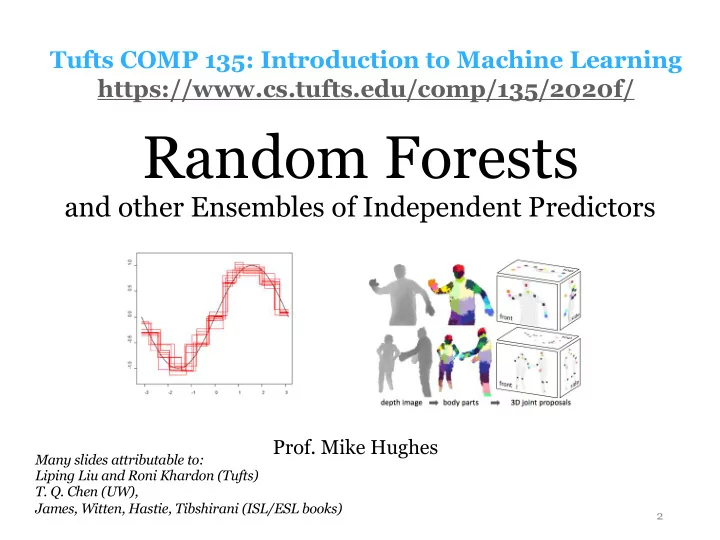

Tufts COMP 135: Introduction to Machine Learning https://www.cs.tufts.edu/comp/135/2020f/ Random Forests and other Ensembles of Independent Predictors Prof. Mike Hughes Many slides attributable to: Liping Liu and Roni Khardon (Tufts) T. Q. Chen (UW), James, Witten, Hastie, Tibshirani (ISL/ESL books) 2
Ensembles : Unit Objectives Big idea: We can improve performance by aggregating decisions from MANY predictors • Today: Predictors are Independently Trained • Using bootstrap samples of examples: “Bagging” • Using random subsets of features • Exemplary method: Random Forest / ExtraTrees • Next class: Predictors are Sequentially Trained • Each successive predictor “boosts” performance • Exemplary method: XGBoost Mike Hughes - Tufts COMP 135 - Spring 2019 3
Motivating Example 3 binary classifiers Model predictions as independent random variables Each one is correct 70% of the time What is chance that majority vote is correct? Mike Hughes - Tufts COMP 135 - Spring 2019 4
Motivating Example 5 binary classifiers Model predictions as independent random variables Each one is correct 70% of the time What is chance that majority vote is correct? Mike Hughes - Tufts COMP 135 - Spring 2019 6
Motivating Example 101 binary classifiers Model predictions as independent random variables Each one is correct 70% of the time What is chance that majority vote is correct? Mike Hughes - Tufts COMP 135 - Spring 2019 8
Key Idea: Diversity • Vary the training data Mike Hughes - Tufts COMP 135 - Spring 2019 10
Bootstrap Sampling Mike Hughes - Tufts COMP 135 - Spring 2019 11
Bootstrap Sampling in Python Mike Hughes - Tufts COMP 135 - Spring 2019 12
Bootstrap Aggregation: BAgg-ing • Draw B “replicas” of training set • Use bootstrap sampling with replacement • Make prediction by averaging Mike Hughes - Tufts COMP 135 - Spring 2019 13
Regression Example: 1 tree Image Credit: Adele Cutler’s slides
Regression Example: 10 trees The solid black line is the ground-truth, Red lines are predictions of single regression trees Image Credit: Adele Cutler’s slides
Regression Average of 10 trees The solid black line is the ground-truth, The blue line is the prediction of the average of 10 regression trees Image Credit: Adele Cutler’s slides
Binary Classification Image Credit: Adele Cutler’s slides
Decision Boundary: 1 tree Image Credit: Adele Cutler’s slides
Decision boundary: 25 trees Image Credit: Adele Cutler’s slides
Average over 25 trees Image Credit: Adele Cutler’s slides
Variance of averages • Given B independent observations z 1 , z 2 , . . . z B • Each one has variance v • Compute the mean of the B observations B z = 1 X z b ¯ B b =1 • What is variance of this estimator? Mike Hughes - Tufts COMP 135 - Spring 2019 21
Why Bagging Works: Reduce Variance! • Flexible learners applied to small datasets have high variance w.r.t. the data distribution • Small change in training set -> big change in predictions on heldout set • Bagging decreases heldout error by decreasing the variance of predictions • Bagging can be applied to any base classifiers/regressors Mike Hughes - Tufts COMP 135 - Spring 2019 22
Another Idea for Diversity • Vary the features Mike Hughes - Tufts COMP 135 - Spring 2019 23
Random Forest Combine example diversity AND feature diversity For t = 1 to T (# trees): Draw independent bootstrap sample of training set. Greedy train tree on random subsample of features For each node within a maximum depth : Randomly select M features from F features Find the best split among these M features Average the trees to get predictions for new data. Mike Hughes - Tufts COMP 135 - Spring 2019 24
Credit: ISL textbook Single tree Mike Hughes - Tufts COMP 135 - Spring 2019 25
Extremely Randomized Trees aka “ExtraTrees” in sklearn Speed , example diversity, and feature diversity For t = 1 to T (# trees): Draw independent bootstrap sample of training set. Greedy train tree on random subsample of features For each node within a maximum depth : Randomly select m features from F features Find the best split among M variables Try 1 random split at each of M variables, then select the best split of these Mike Hughes - Tufts COMP 135 - Spring 2019 26
Mike Hughes - Tufts COMP 135 - Spring 2019 27
Mike Hughes - Tufts COMP 135 - Spring 2019 28
Applications of Random Forest in Industry Microsoft Kinect RGB-D camera How does the Kinect classify each pixel into a body part? Mike Hughes - Tufts COMP 135 - Spring 2019 29
Mike Hughes - Tufts COMP 135 - Spring 2019 30
Summary: Ensembles of Independent Base Classifiers • Average over independent base predictors • Why it works: Reduce variance • PRO • Often better heldout performance than base model • CON • Training B separate models is expensive, but can be parallelized Mike Hughes - Tufts COMP 135 - Spring 2019 31
Recommend
More recommend